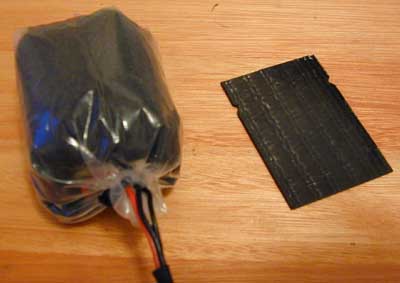Length-wise balancing
Some people suggested that nose- or tail-heavy helis have problems when flying fast. Although my heli was nose-heavy, I did not really have problems with that, but I had some drift problems when flying inverted. This could be caused by the trim you have to put in to counterbalance weight inbalances. This trim acts in the wrong direction when inverted, effectively doubling the drift. Therefore I decided to balance the heli as good as possible.
To check whether your heli is nose- or tail heavy, half fill the fuel tank. Lift the heli by the main blades and hold the heli on its side, as if it is halfway a roll to inverted. If the nose comes down it is nose heavy. My raptor is actually balanced when I put only a receiver (without batteries) in the nose. As most raptors have much more (receiver battery, gyro) in the nose, I think most raptors are nose-heavy.
To balance the heli properly, I moved the battery pack from the nose to right on top of the tank, and put the gyro and receiver in the front. To do this you need thin batteries, not the typical racing-pack cells but for instance the Sanyo 1700 cells I use, and the cells have to be reconfigured in a 2x2 configuration to make a long 'box' sized shape. This balances the whole heli (both raptor 30 and raptor 50) in the lengthwise direction, the nose is only slightly heavy when the fuel tank is half full.

The V2 has a higher tank, causing troubles even to fit a small pack on the tank. I made a carbon plate fitting on top of the battery pack, to make sure that the top stays below the tail belt. The plate is then pulled down with a tierap, keeping the pack and plate fixed on top of the tank.

I compared both configurations (batteries in front versus on top of the tank).
But for inverted flight, the heli will drift less when it is properly balanced.
To keep the heli still, I did not need continuous cyclic anymore.
For straight-up, hardly any difference is noticeable.
As noticed, the balance is good with the battery on the back,
but the heli remains a little nose-heavy.
I tried to make the balance perfect by adding 15 grams of lead in the tail.
This flew very good when inverted, but it lowered the pirouetting rates,
and made the helicopter feel very sluggish.
Concluding, this modification is not important for normal fliers,
but I recommend it for 3D flyers to get the heli tuned optimal when flying inverted.